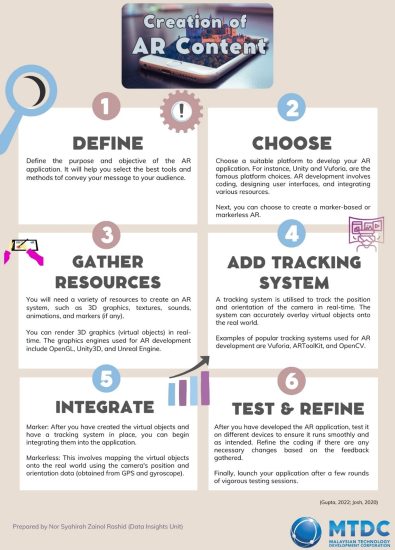About Augmented Reality
Augmented reality (AR) is defined as a technology that combines computer-generated images on a screen with the real object or scene that you could look at (Oxford University Press, n.d.). It is an enhanced version of the real physical world that is achieved by utilising digital visual elements, sound, or other sensory stimuli.
This article came about in response to a request from a colleague. Happy reading.
Different Types of AR
There are three types of AR, namely marker-based, markerless and location-based, to create various contents that suit the company’s requirements.
- Marker-based AR
Marker-based AR relies on a specific AR marker to trigger the experience. AR Marker is a distinct pattern / image that cameras can easily recognise and process (Aircards.com, n.d.). It is visually independent of the surrounding environment. You can choose a paper-based or physical object. Common markers are logos, product packaging or
QR codes. The marker’s shape or image must be unique and easily identifiable by the camera in different environments (Aircards.com, n.d.). Another key aspect of marker-based Augmented Reality is that the AR experience is linked to the marker’s location. Typically, the experience is displayed over the marker and moves with it as it is turned or rotated. Examples of various AR markers are as follows:

- Markerless AR
Markerless AR scans the real world and places digital elements on identifiable features such as flat surfaces. Instead of being linked to a marker, digital elements are positioned based on geographical position. Furthermore, it is popular in games and entertainment such as Pokémon Go, where characters move around the environment in the interactive game (Aircards.com, n.d.). AR can also be used to enrich the user’s experience in live events and allow virtual product placements as part of a company’s marketing activities. With Markerless AR, the app uses GPS, accelerometer or digital compass to detect the user’s position and overlay the augmented reality object.
Location-based AR, also known as GPS-based or Geo-based AR, is less common than Marker-based and Markerless AR but is particularly relevant in the travel and tourism industries. As the name suggests, digital elements are placed based on physical locations.
For example, Google Inc. is developing its Google AR Maps, a location-based AR. Users can scan the buildings to gather their actual location. Then, users can observe directional prompts overlaid on their travel path (Aircards.com, n.d.; Hayes, 2022). Google AR Maps is still in its early stages but has high potential as a useful and informational resource. The app could include additional features like digital elements for famous landmarks and businesses. The app could display additional historical information and business star ratings hovering above locations as users pass by. A brief review of the Google AR Maps is per the YouTube video, click here (Wall Street Journal, 2019).
Steps of Creating AR Content

References
Aircards.com. (n.d.). Markerless vs. Marker-based AR with Examples. Retrieved 13 April 2023, from https://www.aircards.co/blog/markerless-vs-marker-based-ar-with-examples
Hayes, A. (2022, October 29). Augmented Reality (AR) Defined, with Examples and Uses. https://www.investopedia.com/terms/a/augmented-reality.asp
Oxford University Press. (n.d.). Augmented-reality noun—Definition. Retrieved 12 April 2023, from https://www.oxfordlearnersdictionaries.com/definition/english/augmented-reality?q=augmented+reality
Wall Street Journal (Director). (2019, February 13). A First Look at Google Maps’ AR Future. https://www.youtube.com/watch?v=QW1QT7DOOdA
